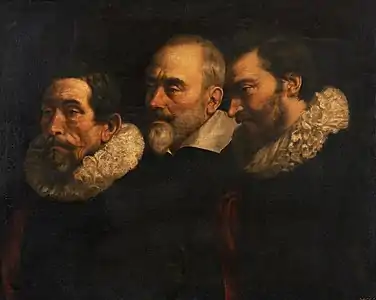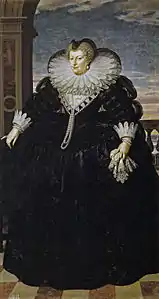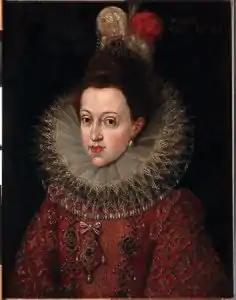Frans Pourbus the Younger | |
|---|---|
 Detail from Charles d'Arenberg and Anne de Croy with family, possibly a self portrait of the painter | |
| Born | Frans Pourbus c. 1569 Antwerp |
| Died | 19 February 1622 (aged 53) Paris |
| Nationality | Flemish |
| Known for | Portrait |
| Patron(s) | Archduke Albert and the Infanta Isabella; Vincenzo Gonzaga, Duke of Mantua; Marie de Médici |
Frans Pourbus the Younger (1569–1622) was a Flemish painter, son of Frans Pourbus the Elder and grandson of Pieter Pourbus. He was born in Antwerp and died in Paris. He is also referred to as "Frans II".
Pourbus was a successful court painter for, successively, the Habsburg family in Brussels, the Gonzaga Duke of Mantua (1600-1609), and then the French court. The majority of his work was royal portraits, many full-length, but he also painted some altarpieces. He painted the Brussels-based Spanish Regents of the Netherlands, the Duke of Mantua and Marie de' Medici, Queen of France. Works of his can be found in the Royal Collection, the National Museum in Warsaw, the Louvre, the Prado, the Rijksmuseum, the Royal College of Art, the Metropolitan Museum of Art and many other museums.[1][2]
Pourbus produced portraits that were pleasing to his patrons, but somewhat static with no dramatic situations, or landscape backgrounds.[3] He is noted for his depiction of costume, jewellery and draperies, as in his portrait of Henry IV of France (below).[4][5]
Patronage
Pourbus completed his apprenticeship in Antwerp in 1591.[6] At the end of the 16th century, he worked for Archduke Albert and the Infanta Isabella in Brussels.[5] On 27 June 1600, he was paid for a portrait of the Infanta (see below). This was subsequently presented to Anne of Denmark (wife of James VI and I) by the Ambassador of the Spanish Netherlands and this work remains in the Royal Collection.[2]
In 1600, he was recruited as court painter in Mantua by Vincenzo Gonzaga, Duke of Mantua who met him when Gonzaga was on a visit to the Netherlands buying works of art.[7] Within months of his appointment, Peter Paul Rubens arrived at the Mantuan court, but there is no evidence of hostility between the two.[3] In 1609, Pourbus moved to Paris at the instigation of Marie de Médici (see her portrait below).[5] It was here that he perfected his style.[4] He worked as Marie de Médici's court painter until his death.
- Pourbus is noted for his depiction of costume, jewellery and draperies.
 Portrait of a man
Portrait of a man
_-_Portrait_of_Isabella_Clara_Eugenia_of_Austria_with_her_Dwarf_-_WGA18236.jpg.webp)
_-_(2).JPG.webp)
Death
He died in Paris and was buried on 19 February 1621/2.[5] The exact date of his death is unknown.
The "Anne Boleyn" portrait
Among his works is a portrait of an Italian lady in the Pinacoteca Malaspina, Pavia that has been incorrectly identified as Anne Boleyn, second wife of Henry VIII of England (see below).[8] This identification is a result of a later inscription.[9] The portrait was in any case painted some years after Anne Boleyn's death in 1536.
Other examples of his work
 Portrait of an Italian lady (incorrectly described as Anne Boleyn)
Portrait of an Italian lady (incorrectly described as Anne Boleyn).jpg.webp) Louis XIII, King of France (with the Sash and Badge of the Order of Saint Esprit)
Louis XIII, King of France (with the Sash and Badge of the Order of Saint Esprit)%252C_aartshertog_van_Oostenrijk_Rijksmuseum_SK-A-509.jpeg.webp)
 A man aged 32
A man aged 32 Vincenzo Gonzaga Duke of Mantua
Vincenzo Gonzaga Duke of Mantua Councilors of Paris
Councilors of Paris

_-_Louis_XIII_as_a_Child_-_WGA18241.jpg.webp) Louis XIII of France
Louis XIII of France
 Marie de' Medici
Marie de' Medici
 Philip III of Spain, 1599–1601, The Phoebus Foundation
Philip III of Spain, 1599–1601, The Phoebus Foundation Margaretha of Austria, 1599–1601, The Phoebus Foundation
Margaretha of Austria, 1599–1601, The Phoebus Foundation Portrait of a humanist (Justus Lipsius?), 1595, The Phoebus Foundation
Portrait of a humanist (Justus Lipsius?), 1595, The Phoebus Foundation
References
- ↑ Murray, P. & L. (1996), Dictionary of art and artists. Penguin Books. ISBN 0-14-051300-0.
- 1 2 "The Infanta Isabella Clara Eugenia". Royal Collection Trust. Inventory no. 407377.
- 1 2 Oppenheimer, Paul (2002). Rubens: A Portrait. Rowman & Littlefield. p. 166.
- 1 2 Berger, Robert W (1999). Public Access to Art in Paris. Pennsylvania State University Press. p. 236.
- 1 2 3 4 Your Paintings
- ↑ van Puyvelde, Leo; van Puyvelde, Thierry (1971). Flemish painting, the age of Rubens and Van Dyck. McGraw-Hill. p. 152.
- ↑ Furlotti, Barbara (2008). The Art of Mantua. Getty Publications.
- ↑ For example on page 44 of The Tudors, edited by Antonia Fraser
- ↑ Web Gallery of Art